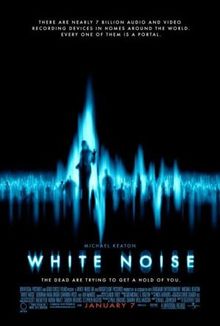
WHITE NOISE
US, 2004, 104 minutes, Colour.
Michael Keaton, Deborah Kara Unger, Chandra West, Ian Mc Niece.
Directed by Geoffrey Sax.
The film opens with what may or may not be a quotation from Thomas Edison. He suggests that there may come a time when technology will be able to pick up messages from the other side. Ghosts and ectoplasm have had to do their bit (and have enlivened many a movie) but White Noise suggests that electronic phenomena, both audio and video (which show up on screens as those oscillating lines of white noise) are on the way to do the trick. At this moment, they are not exactly clear, which gives the film writer enough scenes of recording and enhancing sound to bump up the tension – and there are two jump out of chair scenes as well.
And, if you believe in this kind of messaging from the dead, you will believe anything, especially the alleged statistics offered at the beginning and end. Apparently, a high percentage of such messages are threats rather than friendly.
This is an ordinary and OK show with Michael Keaton grieving over his dead wife and becoming obsessed with the voices from the beyond, especially when he starts rescuing people from disasters that he sees before they happen thanks to his wife’s intervention. One trouble is that all the people she warns about have been clients of the electronic channeller (Ian McNeice). One of them is a bereaved woman, Deborah Kara Unger.
Because the messages involve threats and physical danger, the film is something of a crime thriller as well – giving Michael Keaton plenty of opportunity to be anguished. It’s the kind of plot popular in recent Japanese movies like The Ring, The Grudge, Into the Mirror, Chaos, Deep Water. Perhaps we can look forward this time to a Japanese remake.
1. The popularity of supernatural thrillers? After-death communication with the living? The film as a crime thriller?
2. Washington State, the city, its ordinariness, homes and workplaces, the water, the factories – yet an eerie tone? The musical score?
3. The title and its reference to the sound images? Their significance for after-death communication?
4. EVP, electronic voice phenomena – the quote from Edison, this being put forward as fact? Created by the screenwriter, appealing to audience imagination? The tradition of possibilities for contact, mediums, seances? Ghosts? The technological age, sound waves and images? Why not before? Why now? Why Seattle? Why the limitations in the technology?
5. Audience interest in the supernatural, beliefs, hopes – and scares?
6. The information given at the end on the number of interventions, the good interventions, the threats?
7. Jon and Anna, the opening, the love, their son, Jon’s second marriage, his relationship with Jane? Anna’s book, his entrusting his son to his ex-wife? The situation, at work? Anna’s disappearance, the phone calls, 2.30 am and the strange experience?
8. Anna’s disappearance, playing on the media, the information, time passing, Jon’s hopes?
9. Ray, his staying outside Jon’s house, the workplace, Jon confronting him, Ray giving him the card, Jon thinking he was mad?
10. The police arrival, the news of Anna’s death, his decision to go to Ray, the discussions, the electronic voice phenomena, his experiences? Meeting Sarah, the tea? Supplying the information about Ray and his communications?
11. Ray’s character, the photos, his son, connection with his son? The many years, the range of tapes? His explanation, obsession? The limitations of the technology, enhancing the sound and the images? Raising clients’ hopes? His books, the list of clients, the transcripts – especially the angry spirits?
12. Jon and the communication from Anna, sounds, blurred images, magnifying these? Hearing her words? His discussions with Sarah, visiting the store? Engaging her help?
13. The messages, the warnings, his going to the psychic and the discussion about Willow Avenue? The message, the crash, his saving the baby? The abducted woman? Sarah discovering that the people were on Ray’s list? The puzzles about the warnings and interventions? Images before the events happen?
14. Sarah and her own image, Jon staying with her during the night, his drowsing, his going out, her standing on the balcony, falling, in hospital, recovering?
15. The police, the investigations, questions?
16. Jon, his realisation that he must go to the factory? The pursuit of the killer, the discovery of the worker who had been with him in the stalled elevator? The man and his equipment, communications? Explanation – and Jon’s death?
17. The funeral, Sarah’s presence, his son and his mother and stepfather, the radio contact, the final image of Jon?
18. A satisfying crime thriller, supernatural thriller?